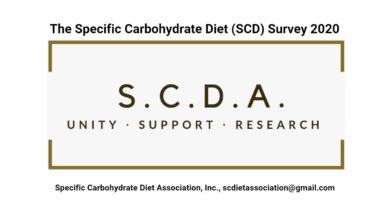SCD饮食可缓解严重溃疡性结肠炎
摘要
A 73-year-old female of Asian origin was diagnosed with ulcerative colitis (UC) after initial gastrointestinal symptoms of abdominal pain and bloody diarrhea. She had a relatively benign course over the subsequent 12 years. In 2009, she had increased left-sided abdominal pain, bloody diarrhea and progressive weight loss, due to a severe exacerbation. In spite of a variety of standard treatments, her condition continued to decline with a significant impact on normal life and functioning. In December of 2010, repeat colonoscopy and microscopy confirmed pancolitis, without diverticulitis. The Specific Carbohydrate Diet (SCD) was initiated due to failure of conventional therapies. Following this highly restricted diet, within a period of 3–6 months, improvement was noted, and within a year, no abdominal pain or diarrhea were present, and she returned to her baseline functioning and career. Two years later, repeat colonoscopy showed resolution of the pancolitis, confirmed with microscopic evaluation. Successful use of the SCD in children with UC has been documented. We describe previously unreported, highly beneficial results with both symptomatic and clinical improvement and complete remission of UC in an adult female with the SCD.
Key Words: Ulcerative colitis, Inflammatory bowel disease, Dietary therapy
一位来自亚洲的73岁女性,最初有胃肠道的腹痛和血性腹泻症状被诊断为溃疡性结肠炎(UC),在随后的12年中,她的病情相对好转。2009年,由于严重病情加重,她的左侧腹痛,血性腹泻和体重减轻有所加重。尽管采取了多种标准治疗方法,但她的病情继续加重,对正常生活和功能产生了重大影响。2010年12月,重复结肠镜检查和显微镜检查证实为全结肠炎。由于传统疗法的失败,开始了特殊碳水化合物饮食(SCD)。严格限制饮食后,在3到6个月内,病情得到改善,一年之内没有腹痛或腹泻,她回到了自己的基本职能和职业生涯。两年后,再次进行结肠镜检查显示结肠炎得以解决,并经显微镜评估证实。有很多文献证明,有很多患有UC的儿童通过使用SCD后成功缓解或者痊愈。
介绍
炎症性肠病(IBD)包括2个主要疾病:溃疡性结肠炎(UC)和克罗恩病。UC是一种慢性炎症性疾病,其特征在于结肠粘膜层的炎症(图1)。其发病机理尚不完全清楚,但研究表明,未知药物会激活免疫细胞。传统的治疗方法包括免疫抑制剂,止泻药和柳氮磺吡啶。
人们怀疑食物抗原会在UC的发展中引发免疫反应。关于可能加重IBD的特定饮食的研究一直存在矛盾。潜在的饮食风险因素包括对牛奶,小麦,精制糖,纤维和典型的“西方”饮食的敏感性。没有成功的科学实验证明到底什么样的饮食有效。
特殊碳水化合物饮食(SCD)由Sidney Haas博士和Elaine Gottschall提出。SCD基于肠道微生物组营养不良与IBD相关的理论。因此,通过改变饮食,肠道菌群有可能被改变,从而导致改善。饮食具有双重作用,不仅消除了可能导致营养不良的因素,而且还包括恢复肠道微生物组的功能。
允许的食物基于碳水化合物的分子结构。单糖是简单的碳水化合物,具有单一结构,易于吸收和消化。单糖的食物包括水果,一些蔬菜,蜂蜜和酸奶。避免使用大多数二糖,多糖和淀粉,因为它们更复杂,更不易消化并且被认为会加剧肠道炎症。发酵酸奶是SCD的重要组成部分,可促进健康肠道菌群的补充。
我们报告了患有ICD的SCD的单例成年患者成功缓解了疾病活动。据我们所知,该病例报告是文献中成人UC的第一个记录案例。
案例报告
A 73-year-old female of Asian origin with a long-standing history of UC presented with the most severe and persistent flare of her disease. She had received the initial diagnosis of UC in 1997 when she developed abdominal pain and rectal bleeding with loose mucous stools and underwent a diagnostic colonoscopy with a gastroenterologist. She responded to mesalamine (Asacol) given for a period of 6 weeks, which was later discontinued by the patient.
For the next 12 years, she was relatively stable with standard American diet recommendations and did not exclude wheat and dairy or focused on the inclusion of particular fermented foods. The patient incorporated powdered ayurvedic and homeopathic oral treatment, which included some spices like nutmeg but did not contain any fresh or fermented products. In the winter of 2009, she experienced intermittent burning and shooting pain predominately in the left lower quadrant of the abdomen. Pain in the right lower quadrant was present often concomitantly, and on occasion, was present in the absence of the left-sided pain. Episodes of rectal bleeding and mucoid loose stools progressed over the duration of the next year. No fever or skin rashes were present at any time. Decreased appetite and overall weight loss of 7 pounds occurred within the 12 months. She was admitted at
assorted facilities and underwent consultations with various gastroenterologists and other specialists, with increasing fatigue and finally, an inability to continue working.
The differential diagnosis included diverticulitis and tuberculosis among others, all of which were excluded. Multiple, episodic and varied therapies including corticosteroids and mesalamine were prescribed, with limited efficacy and poor tolerance. In December of 2010, her weight was 128 pounds, and she appeared pale, fatigued and chronically ill. She had not been able to function as a physician and was in constant abdominal pain with unremitting bloody diarrhea. Hemoglobin of 10.5 g/dl and mild hypokalemia of 3.2 mEq/l was seen with no elevation of the liver enzymes and normal renal function. White blood cell count was normal. Colonoscopy was performed and revealed pancolitis (fig. (fig.1)1) with sigmoid colonic diverticula but no evidence of diverticulitis or neoplastic changes. Mild to moderate IBD consistent with chronic UC was noted with patchy areas through the cecum, ascending, transverse, descending, and sigmoid and rectum, and some difficulty entering the ileocecal valve. The colonic mucosa revealed friability, multiple tiny ulcers and mucosal edema. Biopsies were obtained throughout the colon and confirmed UC.
一位73岁的亚洲裔女性,有长期的UC病史,其疾病最严重且持续发作。她在1997年被初步诊断为溃疡性结肠炎,当时她出现腹痛和直肠出血,并伴有松散的粘液便,并接受了肠胃科医生的诊断性结肠镜检查。她对美沙拉秦(Asacol)有反应,为期6周,后来患者停止服用。
在接下来的12年中,她在标准的美国饮食下下病程相对稳定,没有排除小麦和乳制品,也没有关注特定的发酵食品。该患者采用了草药疗法和顺势疗法口服治疗,其中包括肉豆蔻等香料,但不含任何新鲜或发酵的食品。在2009年冬季,她腹部主要是左下腹出现间歇性烧伤和疼痛。右下腹常伴有疼痛,有时无左侧疼痛。在第二年中,直肠出血和粘液样稀便的情况逐渐恶化。任何时候都没有发烧或皮疹出现。在12个月内食欲下降,体重减轻了7磅。
鉴别诊断包括憩室炎和结核病等,所有这些均排除在外。处方了包括皮质类固醇和美沙在内的多种药物,多种疗法,疗效有限且耐受性差。2010年12月,她的体重为128磅,显得苍白,疲倦且患有慢性疾病。她无法胜任医生的工作,并且持续腹痛,伴有不停的血性腹泻。观察到血红蛋白为10.5 g / dl,轻度低钾血症为3.2 mEq / l,肝酶未升高,肾功能正常。白细胞计数正常。进行结肠镜检查并发现黏膜炎(图。(图。1)1个乙状结肠憩室,但无憩室炎或赘生物改变的证据。轻度至中度IBD与慢性UC相符,盲肠,上升,横向,下降,乙状结肠和直肠有斑片区域,进入回盲肠瓣膜有些困难。结肠粘膜显示易碎,多处小溃疡和粘膜水肿。整个结肠均获得活检并证实为UC

回肠末端(a,b)和盲肠(c)。乙状结肠和左侧结肠的内窥镜照片表明,在73岁的患者UC急性加重1年后,于2010年12月实施SCD之前拍摄了活动性粘膜炎症。在完全结肠镜检查中发现黏膜炎。
由于患者具有持续性和进行性症状,并且临床参数不断恶化,考虑到以前的常规治疗失败,医生因此建议开始SCD 。她开始完全排除小麦,大豆,大麦,玉米和有限的大米。除日常酸奶外,不包括其他乳制品。糖只限于蜂蜜。没有食用含淀粉的蔬菜,并且消除了马铃薯。她主要吃鱼,瘦肉,某些水果和受限制的非淀粉类蔬菜。
在严格限制饮食的情况下,在3到6个月内,患者开始注意到病情改善,频率降低,大便更牢固,大便中没有血液,腹痛得到缓解。在6个月内,她得以恢复正常的工作和职业生涯。虚弱和疲劳消失,体重保持稳定,没有任何恢复。发现贫血已消除,血红蛋白在正常范围内。由于恢复良好,她继续严格遵守饮食习惯,并在接下来的18个月中消除了所有症状。
在2012年12月开始饮食后的两年内进行了随后的结肠镜检查,内窥镜检查结果显示明显没有任何炎症(图2)。同时获得的活检证实了UC的完全缓解,没有炎症活动。从那时起,她注意到意外食用小麦,胡椒和其他未经批准的SCD食物会引起急性发作,而迅速清除这些食物会在几天内改善症状。自从饮食开始以来,她就不需要住院或接受UC的其他治疗,并且IBD基本上可以缓解。

回肠末端(a,b)和盲肠(c)表现出正常的结肠粘膜,SCD两年后未发炎(2012年12月)。完全的结肠镜检查证实了结肠所有节段的分辨率
讨论区
UC is known to have a peak in the age groups of 15–30 and 60–80 years . In both children and adults, there are numerous diets and complementary therapies that have been used. However, at this time, there is little consensus among the complementary therapies. While gluten-free diets have been used for IBD in adults, the SCD has been found to be successful in a small retrospective study of 7 children . Our case demonstrated unprecedented healing of recalcitrant and remitting UC, following institution of the SCD, in an adult.
This case study demonstrates the easy tolerability and lack of significant side effects of the SCD. Confirmation of healing with endoscopy and microscopy validates the clinical improvement experienced by this patient. The diet requirements were relatively simple to incorporate though highly restrictive and are similar to those undertaken with celiac disease but included a prominent component of fermented dairy. A major strength of this case study is the ease of translation into clinical practice by busy clinicians, without the need for additional resources.
One of the limitations of this case study was the absence of definitive serological testing for celiac disease prior to the institution of the diet to determine occult gluten sensitivity. A further limitation of the dietary intervention are the restricted choices available outside of the home and the difficulty with absolute long-term adherence.
However, similar to patients with celiac disease, the food choices for patients on restricted diets has been steadily increasing in the United States, with gluten-free options having had a 63%percnt; increase in sales from 2012 to 2014. We anticipate that with greater promulgation of elimination diets, it will be more conducive to adhere outside of the home environment.
We would recommend that physicians and dieticians who are involved with gastrointestinal diseases look into alternative therapies, not only for patients with celiac disease but potentially also for those with IBD and UC. Further testing for specific food allergens and gut microbiome dysfunction could be helpful. Our suggestion is that future studies incorporate genetic markers and serological testing prior to making the changes.
The SCD has been used anecdotally for UC; however, the evidence of its effectiveness has not been conclusive. We report complete healing of UC in a patient who had failed conventional therapies within a 2-year period. The use of the SCD for UC in patients who are able to make sustainable dietary changes should be considered more often.
众所周知,UC在15-30岁和60-80岁这两个年龄段有双峰峰值[4]。无论是儿童还是成人,都有大量的饮食和辅助疗法。然而,在这个时候,在互补疗法中几乎没有共识。尽管无麸质饮食(GFCF)已用于成人IBD,但SCD在一项对7名儿童的小型回顾性研究中被发现是成功的[5]。我们的病例显示,继SCD治疗后,一名成人出现了前所未有的顽固性和缓解性UC的愈合。。
该案例研究证明了SCD易于耐受并且没有明显的副作用。通过内窥镜检查和显微镜检查确认治愈,证实了患者的临床改善。饮食要求虽然相对严格,但相对来说却比较容易摄入,与乳糜泻相似,但其中包括发酵乳(scd酸奶)的重要组成部分。该案例研究的主要优势在于,繁忙的临床医生可以轻松地将其转换为临床实践,而无需额外的资源。
该案例研究的局限性之一是,在确定饮食的潜伏性面筋敏感性之前,没有对乳糜泻进行明确的血清学检测。饮食干预的另一个局限性是在家庭外的选择受限,以及长期坚持的困难。
然而,与乳糜泻患者相似,在美国,限制饮食患者的食物选择一直在稳步增加,无麸质食品的比例为63%;2012年至2014年的销售额有所增加[6]。我们预计,随着限制饮食的更广泛的颁布,它将更有利于坚持在家庭以外的环境。
我们建议与胃肠道疾病有关的医生和营养师不仅要对腹腔疾病患者,而且还应对IBD和UC患者进行研究。进一步测试特定的食物过敏原和肠道微生物组功能障碍可能会有所帮助。我们的建议是,在进行更改之前,未来的研究应结合遗传标记和血清学检测。
SCD已被UC广泛使用;但是,其有效性的证据尚无定论。我们报告了在2年内常规治疗失败的患者中UC的完全治愈。应该更坚定地考虑将SCD用于能够持续改变饮食的UC患者。
脚注
该病例报告以前曾在2015年实验生物学会议上作为海报展示。该病例报告的摘要先前已在其相应的期刊[FASEB J 2015; 29:912.7]上的2015年实验生物学大会上发表。
参考资料
1. Gasche C,Scholmeric J,Brynskov J等。克罗恩氏病的简单分类:世界胃肠病学大会工作组的报告,维也纳,1998年。InflammBowel Dis。2000; 6:8。[ PubMed ] [ Google Scholar ]
2. Peppercorn MA:炎性肠病的定义,流行病学和危险因素;在Grover S(ed)中:UptoDate。2015年。http://www.uptodate.com/contents/definition-epidemiology-and-risk-factors-in-immuno-bowel-disease。
3. Gottschall E. 打破恶性循环。柯克顿:柯克顿出版社;1994. [ Google Scholar ]
4. Harrison T,Longo D. Harrison的医学手册。纽约:麦格劳-希尔医疗公司;2013. [ Google Scholar ]
5. Suskind DL,Wahbeh G,Gregory N,Vendettuoli H,ChristieD。小儿克罗恩病的营养疗法:特定的碳水化合物饮食。J Pediatr胃肠食品。2014; 58:87-91。[ PubMed ] [ Google Scholar ]
6. 无麸质食品激增63%;在过去两年中。英敏特集团有限公司;2014年 。http://www.mintel.com/press-centre/food-and-drink/gluten-free-foods-surge-63-percent。[ Google Scholar ]





